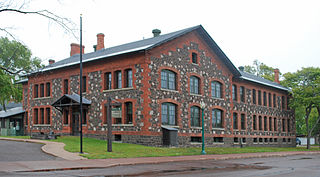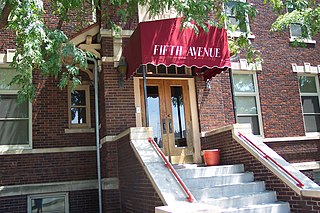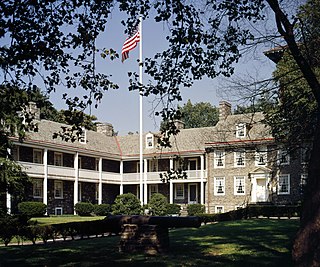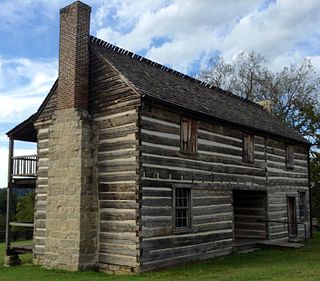
Baxter County is a county in the U.S. state of Arkansas. As of the 2020 census, the county's population was 41,627. The county seat is Mountain Home. It is Arkansas's 66th county, formed on March 24, 1873, and named for Elisha Baxter, the tenth governor of Arkansas.

The Old State House, formerly called the Arkansas State House, is the oldest surviving state capitol building west of the Mississippi River. It was the site of the secession convention, as well as the fourth constitutional convention when delegates agreed to ensure voting rights for freedmen and establish public education.

Keweenaw National Historical Park is a unit of the U.S. National Park Service. Established in 1992, the park celebrates the life and history of the Keweenaw Peninsula in the Upper Peninsula of the U.S. state of Michigan. As of 2009, it is a partly privatized park made up of two primary units, the Calumet Unit and the Quincy Unit, and 21 cooperating "Heritage Sites" located on federal, state, and privately owned land in and around the Keweenaw Peninsula. The National Park Service owns approximately 1,700 acres (690 ha) in the Calumet and Quincy Units. Units are located in Baraga, Houghton, Keweenaw, and Ontonagon counties.

The Fort Smith Trolley Museum is a streetcar and railroad museum in Fort Smith, in the U.S. state of Arkansas, which includes an operating heritage streetcar line. The museum opened in 1985, and operation of its streetcar line began in 1991. Four vehicles in its collection, a streetcar and three steam locomotives, are listed on the National Register of Historic Places (NRHP). The now approximately three-quarters-mile-long (1.2 km) streetcar line also passes four NRHP-listed sites, including the Fort Smith National Historic Site, the Fort Smith National Cemetery, the West Garrison Avenue Historic District and the 1907 Atkinson-Williams Warehouse Building, which now houses the Fort Smith Museum of History.

The Ford Hospital, also called the Fifth Avenue Hotel, is located in downtown Omaha, Nebraska. Built in 1916 by Home Builders Incorporated, the hospital was a privately operated facility built and operated by Dr. Michael J. Ford. Operating until 1922, it was the last small, private hospital in the city. Originally designed by James T. Allan, the building stylistically is a unique blend of elements from the Second Renaissance Revival and the Arts and Crafts movements. The building was sold and remodeled as the Fifth Avenue Hotel in 1929, a name referring to the nickname Douglas Street obtained after the installation of new electric lights in 1927. The building was again converted in 1987, and currently serves as apartments.
Historic preservation in New York is activity undertaken to conserve forests, buildings, ships, sacred Indian burial grounds, water purity and other objects of cultural importance in New York in ways that allow them to communicate meaningfully about past practices, events, and people. Governmental programs for historic preservation range from Federal ownership and active operation of sites to grants and subsidies provided by state government, municipal support of museums and interpretative displays. Nonprofit programs include activities of statewide and local historical associations and museums, and activities of historical societies and museums at the national level. Quasi-governmental organizations, such as the New York State Thruway Authority and Thousand Islands Bridge Authority, play a role as well. Private endeavors, such as investment and other choices made by private landowners to conserve historical features of their properties, are significant but less visible and include groups such as the Historic Districts Council, The New York Landmarks Conservancy and the Preservation League of New York State. During the reconstruction of the World Trade Center site in July 2010, a team of archaeologists discovered a 32-foot-long boat. The craft was at least 200 years old, dating from a time when the Hudson River was partly filled with trash and debris because of a rapidly expanding lower Manhattan.

The Old Barracks Museum, also known just as the Old Barracks, is a historic building located at 101 Barracks Street in Trenton, Mercer County, New Jersey. Built in 1758 to house soldiers of the British Army, it is the only remaining colonial barracks in the state and is one of the only tangible surviving elements of the 1776 Battle of Trenton. The building was added to the National Register of Historic Places on January 25, 1971 and listed as a National Historic Landmark on November 28, 1972, for its significance in military history. It is now a state-run historic site and museum.

The Baxter Mill is a historic gristmill on Massachusetts Route 28 in West Yarmouth, Massachusetts. Built about 1710 and restored to working order in 1961, it is the only surviving 18th-century water-powered mill on Cape Cod. It is now a museum property owned by the town and operated by the Yarmouth Historical Commission. The mill was listed on the National Register of Historic Places in 1981.

The dogtrot, also known as a breezeway house, dog-run, or possum-trot, is a style of house that was common throughout the Southeastern United States during the 19th and early 20th centuries. Some theories place its origins in the southern Appalachian Mountains. Some scholars believe the style developed in the post-Revolution frontiers of Kentucky and Tennessee. Others note its presence in the South Carolina Lowcountry from an early period. The main style point was a large breezeway through the center of the house to cool occupants in the hot southern climate.

Elizabeth Bard Memorial Hospital, now known as The Elizabeth Bard Memorial Building, is a historic building in downtown Ventura, California. Built in 1901, it is a Mission Revival structure featuring covered terraces and a covered porch with a three-story bell tower at the southeast corner. The building was listed as Ventura Historic Landmark No. 19 in 1976 and was added to the National Register of Historic Places in 1977.

The Cashier's House is a three-story stuccoed-brick, Greek Revival building located on State Street in Erie, Pennsylvania. It was documented by the Historic American Buildings Survey in 1934. The house was listed on the National Register of Historic Places on January 13, 1972, and its boundary was increased on March 9, 1983.

Hermione, now the Hermione Museum, is a Greek Revival-style plantation house built in 1853 or 1855 on Kell Plantation in Madison Parish, Louisiana. In 1997 it was donated to the Madison Historical Society and moved to the parish seat of Tallulah.

The Old Astoria City Hall, now known as the Clatsop County Historical Society Heritage Museum, is a historic building located in Astoria, Oregon, United States, that is listed on the National Register of Historic Places. The building served as the city hall of Astoria from 1905 until 1939. It was the first location of the Columbia River Maritime Museum, from 1963 to 1982, and has been the Heritage Museum since 1985.

The McCollum-Chidester House is a historic house at 926 Washington Street NW in Camden, Arkansas. It is now a museum operated by the Ouachita County Historical Society, along with the Leake-Ingham Building at the rear of the property. The 1+1⁄2-story wood-frame house was built in 1847 by Peter McCollum and sold ten years later to Colonel John T. Chidester. It is one of the finest pre-Civil War Greek Revival mansions in the state. Chidester was a prominent businessman who controversially sought to do business with Union interests during the Civil War. After the war he established a mail company that operated so-called "Star routes" as far west as the Arizona Territory. He was not implicated in bribery scandals that attended this operation.

The Jacob Wolf House is a historic house on Arkansas Highway 5 in Norfork, Arkansas. It is a log structure, built in 1825 by Jacob Wolf, the first documented white settler of the area. Architecturally it's a "saddle bag", which is a two-story dog trot with the second floor built over the open breezeway. A two-story porch extends on one facade, with an outside stair giving access to the upper floor rooms. The building's original chinking has been replaced by modern mortaring. It is maintained by the Department of Arkansas Heritage as a historic house museum.

The Old Scott County Jail is a historic former county jail at 125 West 2nd Street in Waldron, Arkansas. It is currently home to the Scott County Historical and Genealogical Society. The building is a two-story structure, built of fieldstone covered in concrete, with a flat roof and a stone foundation. It has a single entrance, which has sidelight windows, and its windows now have decorative shutters rather than iron bars. The jail was built in 1907–08, and was used for its original purpose until the 1930s, when it was adapted for use as Waldron's public library. The library occupied the building between 1938 and 1947, and it was used for a time by local Boy Scout and Girl Scout organizations. It has housed the historical society since 1987.

The Division of Arkansas Heritage (DAH) is a division of the Arkansas Department of Parks, Heritage, and Tourism of the U.S. State of Arkansas responsible for preserving, promoting, and protecting Arkansas's natural and cultural history and heritage. It was known as the Department of Arkansas Heritage until it was merged with the Arkansas Department of Parks and Tourism (ADPT) on July 1, 2019, becoming a division of ADPT's successor, the Arkansas Department of Parks, Heritage, and Tourism.


















